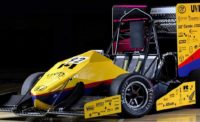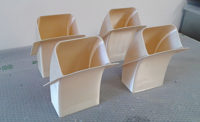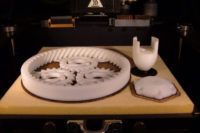Additive manufacturing has been crucial in the motor sports world for years. In the race for speed and performance, it has been a lynchpin for design and testing. Now, race teams are discovering that additive manufacturing can be used for more than simply producing and evaluating new part designs. The technology can produce parts that are ready to hit the track and endure the rigors of high-speed racing.
Motor sports teams are using the technology for direct digital manufacturing (DDM) of production parts. In doing so, teams have demonstrated that parts made via additive manufacturing have the quality and durability to meet the demands of race cars of all types.
NASCAR
Stewart-Haas Racing uses additive manufacturing to accelerate the rollout of new part designs. According to senior design engineer Matt Johnson, the team uses the Stratasys fused deposition modeling (FDM) process to save machine shop time and material expense.
“We always find ways to improve our design from our prototypes,” says Johnson. “We make revised parts without having to take the time to do a new CNC tool-up and procure more material.”
Within five months of obtaining the FDM machine, Stewart-Haas was using the machine to produce race-ready parts for its #39 and #14 cars.
A good example is an oversized knob for a radio. The knob has a D-shaped hole for mounting onto a stem. This simple feature would have been a challenge for CNC. “To machine the small D-shaped hole would have been very time consuming,” says Johnson. “Additive manufacturing was an easier solution.”
Another example is the ducting used to direct air to—and carbon monoxide from—the driver. Ideally, the duct connectors should be custom-made to fit each vehicle. But the usual options for making the connectors—machining, molding or composite lay-ups—are expensive and time-consuming. Off-the-shelf connectors would be less than optimal.
Additive manufacturing provides a perfect alternative. Within a few hours of completing a design, Stewart-Haas can produce custom connectors that optimize air routing to improve airflow and driver comfort.
Joe Gibbs Racing has been using FDM for several years. Like Stewart-Haas, Joe Gibbs Racing acquired an FDM machine as a design and evaluation tool but later expanded its applications to include pattern making and DDM. The team used the technology to produce 225 carbon monoxide filter housings for the 2014 race season. According to design engineer Brian Levy, six of the two-piece housings will be used each race weekend.
Levy explained that the filter housing is made from polycarbonate, which was selected for its ability to withstand a temperature of 200 F over a four-hour race. The optimized housing design leverages FDM’s ability to reduce weight to the bare minimum.
“It is a design that would be very difficult and time-consuming to CNC machine,” says Levy. “We produce 10 a day in one run with our FDM machine. And we make them on demand, which we could never do with our CNCs. The CNC mills always have long queues, so anything that we can offload to FDM is very beneficial, especially when we are ramping up for race season.”
World Rally Championship
The World Rally Championship pits cars and drivers in a series of two-, three- or four-day events through some of the toughest and most varied conditions on the planet. At top speed, cars race along tree-lined, gravel courses with blind crests and big jumps. Rally cars have hit jumps at 100 mph and have flown more than 175 feet for three to four seconds of airtime. If the design team gets it wrong, the jarring impact on landing can bend the chassis, rip out the suspension, or injure the driver.
U.K.-based Prodrive is one of the world’s largest and most successful motor sports and vehicle technology businesses, with annual sales of around $156 million and a staff of 700 people worldwide. While the company’s roots are in motor sports, more than half of its business is now involved in developing niche cars and new technology for road vehicles.
The grueling nature of the World Rally Championship series does not stop Prodrive from outfitting its rally car, a John Cooper Works MINI, with up to 15 FDM parts, according to chief designer Paul Doe.
During design and testing of the MINI, FDM was vital in design assessment and testing. Now that the car is racing, Prodrive uses its FDM machine nearly full-time to make production parts, including gauge pods, wheel arches and hood vents. Across all Prodrive team cars and customer cars, these parts have endured upwards of 6,000 miles of abusive rally racing.
Doe cites many advantages to additive manufacturing. Chief among them is cost. “We make only 25 cars per year, so it is hard to justify tooling costs,” he says. “FDM eliminates tooling, which keeps cost down and shortens response time.”
As a designer, Doe also likes that Prodrive can manufacture anything that his crew dreams up, which optimizes performance. “We’re not limited by normal constraints, such as how to de-mold a part from a tool,” he explains. “This opens up new directions and new opportunities for our designs.”
The MINI’s two-piece gauge pod shows what unconstrained design can do for an assembly. Manufactured from ABS, the pod integrates all mounting features and has channels for electrical components. If made from carbon fiber, these features would need to be manually bonded to the pod in secondary operations.
The gauge pod also includes a hollow, yet completely enclosed, mounting brace that maintains strength while minimizing weight. “We couldn’t have done that with any other process,” says Doe. Although it is a nonstructural part, the pod endures impact forces of 5 g on hard landings.
In another example, the MINI’s rear wheel arches were conceived and manufactured in 24 hours. On inspection, the International Automobile Federation (FIA)—the sport’s governing body—took issue with the aerodynamic configuration of the rear wheel area. That afternoon, Prodrive designed the wheel arches to alleviate the FIA’s concerns, manufactured them overnight, and installed them the next morning. “FIA was very impressed with our response time. They reviewed the solution and signed off on the car,” recalls Doe. “Today, all our MINI’s are racing with FDM-made wheel arches.”
The wheel arches take a beating from gravel when drivers drift around corners. Even so, none have failed. “During rallies, our only failure has been the bond [between the part and] the car,” Doe says.
A final example of how Prodrive uses additive manufacturing is for the MINI’s hood vent, which was produced with FDM. Instead of a simple lip to dress the opening, Prodrive optimized the design for aerodynamics. The shape makes molding or carbon fiber lay-up very difficult, but with additive manufacturing, production is simple. The vent is stiff, light and heat resistant. It extracts air passing over the turbo and exhaust, which can run as high as 1,800 F.
But performance was not the only requirement placed on the vent. At the last minute, MINI’s manufacturer, BMW stepped in and requested a central hood louver for styling. Since FDM eliminates tooling, Prodrive had no problems with manufacturing this redesigned part. This is another advantage that Doe welcomes. There is no commitment to a design; Prodrive can alter its parts as needed.
“The FDM technology is so easy to use, sometimes I have to rein people in,” says Doe. “They are designing wild ideas just because they can. A lot of the time, we can’t justify not using FDM.”
Although the racing world has proved DDM’s role in reaching peak performance, consumers have only seen the tip of the iceberg. However, the day will come soon when everyday vehicles will be equipped with standard and custom parts made via additive manufacturing.









